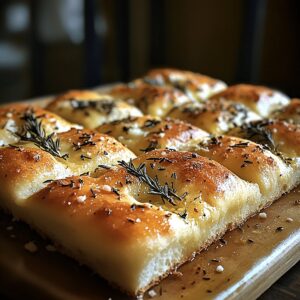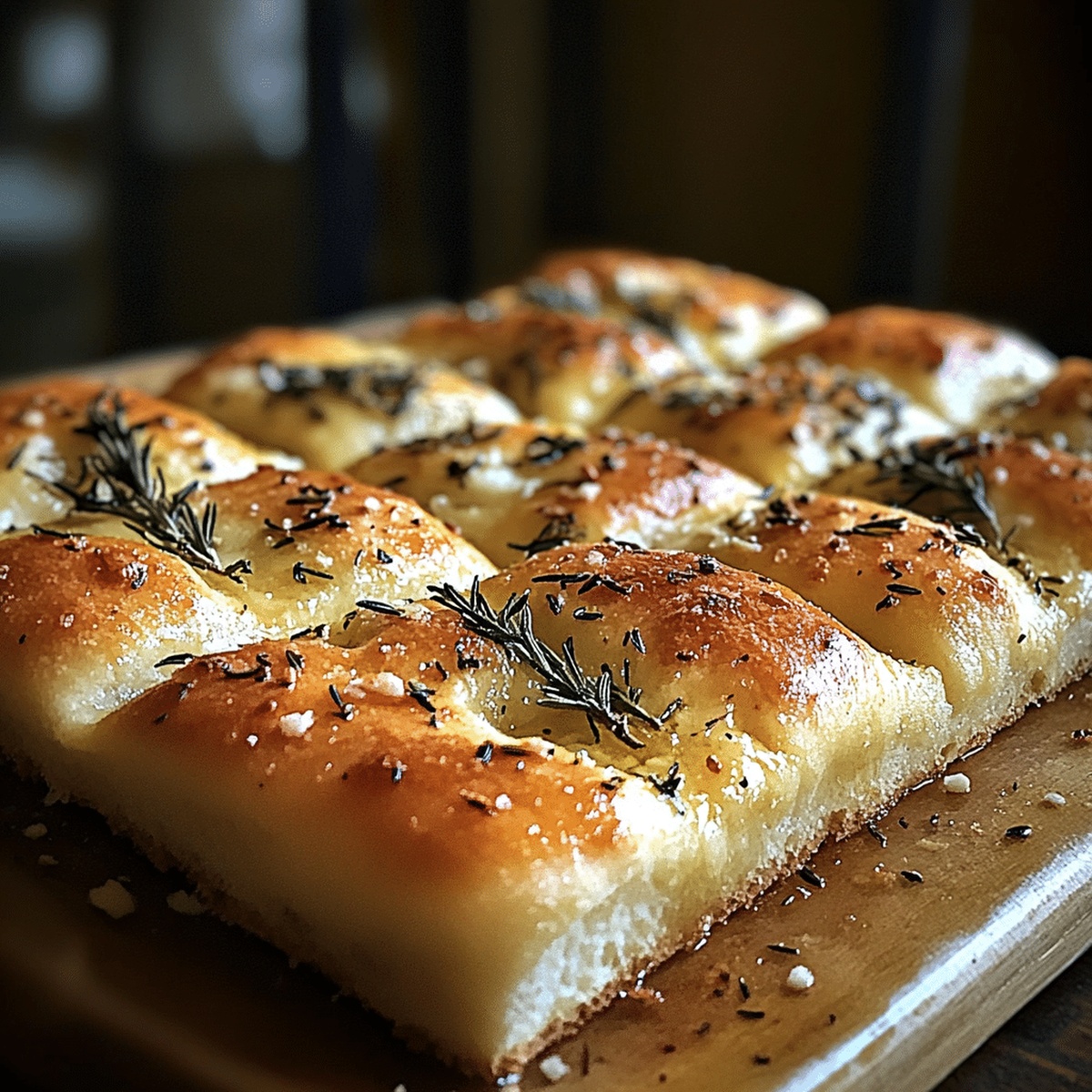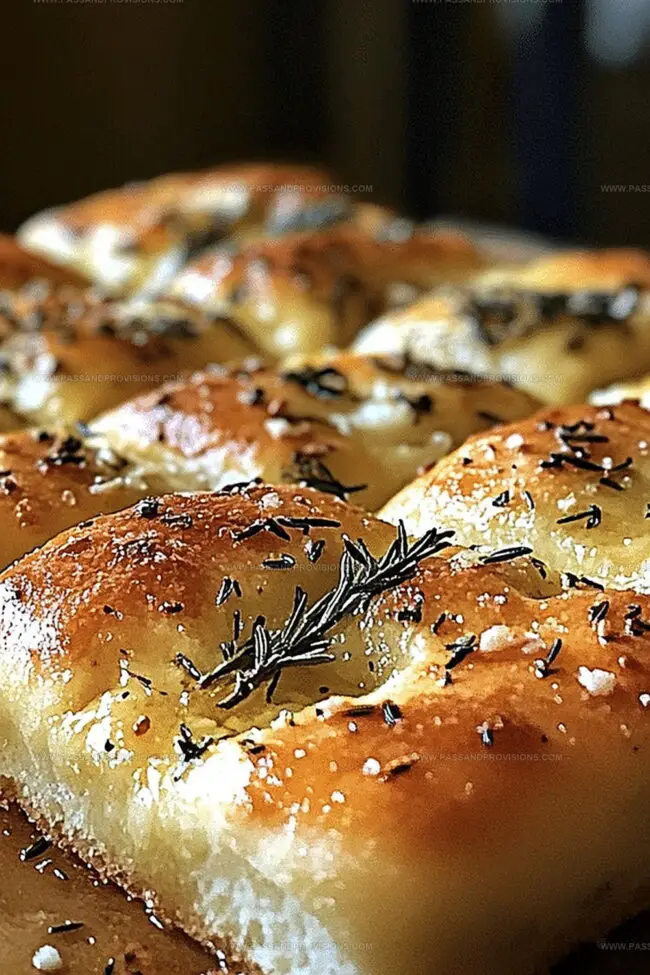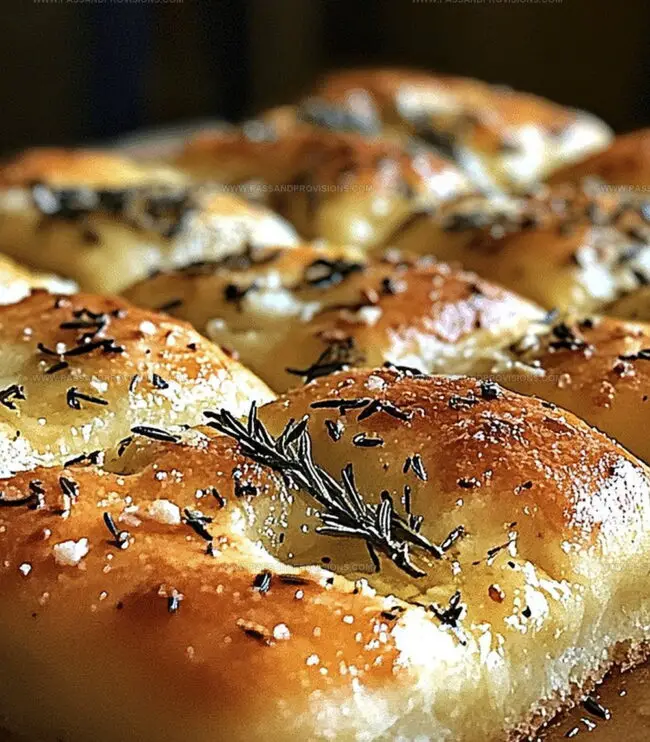Easy Lemon, Rosemary, and Parmesan Focaccia Recipe That Wows
A golden, crusty lemon rosemary focaccia always sparks conversations at dinner tables.
Mediterranean kitchens have perfected this artisan bread’s delicate balance of flavors.
Herbs dancing across a pillowy surface create magical moments for curious cooks.
Salt crystals glisten like hidden treasures amid fragrant rosemary sprigs.
Warm bread straight from the oven beckons with irresistible aromas that fill every corner.
Fresh ingredients combine into something extraordinary, promising a sensory adventure.
Each slice tells a story of rustic simplicity and culinary passion.
You will want to slice, share, and savor every delectable bite.
Why This Focaccia Deserves a Spot on the Table
Ingredients That Build Flavor in Layers
Yeast and Flour Base:Flavor Enhancers:Moisture and Texture Ingredients:How to Bake Focaccia With Bold Aromatics
Step 1: Awaken the Yeast
Grab a cozy small bowl and mix warm water, sugar, and yeast. Let the mixture hang out and get bubbly for about 5-10 minutes until it looks frothy and alive.
Step 2: Create the Dough Base
In a roomy mixing bowl, toss together:Add the yeast mixture, olive oil, rosemary, lemon zest, and Parmesan cheese. Blend everything until a soft, shaggy dough comes together.
Step 3: Massage the Dough
Move the dough onto a lightly floured surface. Knead it with love for 8-10 minutes until it becomes smooth and stretchy. If you have a stand mixer, let the dough hook do the work for about 5 minutes.
Step 4: Let the Dough Rest and Grow
Place the dough in a greased bowl, cover with a clean kitchen towel, and park it in a warm spot. Allow it to rise and double in size, which takes about 1-1.5 hours.
Step 5: Prepare the Baking Stage
Grease a 9×13-inch baking pan or line it with parchment paper. Gently punch down the dough and spread it evenly across the pan.
Step 6: Add Flavor Boosters
Drizzle olive oil generously over the dough. Use your fingers to create charming dimples across the surface. Sprinkle with:Step 7: Second Rise
Cover the pan and let the dough rise again for 20-30 minutes. Meanwhile, heat your oven to 400°F (200°C).
Step 8: Bake to Golden Perfection
Slide the pan into the oven and bake for 20-25 minutes until the top turns a beautiful golden brown and looks crispy.
Step 9: Cool and Devour
Let the focaccia cool slightly, then slice and serve. Enjoy warm or at room temperature with a side of olive oil for dipping.
Tricks for a Golden Crust and Soft Center
Store and Reheat Without Losing That Crust
Serve With These Winning Combos
Lemon and Herb Variations to Test Out
FAQs for Focaccia First-Timers
Warm water (around 110°F) helps activate the yeast by creating the perfect environment for it to wake up and become frothy, ensuring the dough will rise properly.
Yes, you can use dried rosemary, but use about 1/3 of the amount since dried herbs are more concentrated in flavor. Fresh rosemary provides a more vibrant taste and aroma.
The dough is properly kneaded when it becomes smooth, elastic, and springs back when gently pressed. It should feel soft and not sticky, which typically takes 8-10 minutes of kneading.
Dimpling creates signature focaccia texture, helps distribute olive oil, and allows the bread to develop those characteristic crispy peaks and soft interior during baking.
Print
Lemon, Rosemary, And Parmesan Focaccia Recipe
- Total Time: 45 minutes
- Yield: 12 1x
Description
Rustic Italian “Lemon, Rosemary, and Parmesan Focaccia” brings Mediterranean sunshine to your kitchen. Fragrant herbs, zesty citrus, and salty cheese create a perfect harmony that invites friends and family to savor each golden, crispy slice.
Ingredients
Main Ingredients:
- 3 ½ cups (875 milliliters) all-purpose flour
- 1 ¼ cups (296 milliliters) warm water
- ¼ cup (60 milliliters) olive oil
Bread Base Ingredients:
- 1 packet (2 ¼ teaspoons/7 grams) active dry yeast
- 1 teaspoon (5 grams) sugar
- 1 teaspoon (6 grams) salt
Flavor and Topping Ingredients:
- 1 tablespoon (3 grams) fresh rosemary, finely chopped
- ¼ cup (25 grams) grated Parmesan cheese
- Zest of 1 lemon
- Coarse sea salt
- Additional olive oil (for drizzling)
- Additional rosemary (for topping)
- Additional Parmesan cheese (for topping)
Instructions
- Initiate the fermentation process by dissolving yeast in tepid water with a hint of sweetness, allowing the mixture to bloom and become frothy for approximately 5-7 minutes.
- Combine flour and salt in a spacious mixing vessel, then incorporate the activated yeast, fragrant olive oil, aromatic rosemary, vibrant lemon zest, and savory Parmesan cheese until a cohesive dough emerges.
- Transfer the dough to a lightly dusted work surface and knead vigorously, developing gluten and creating a smooth, elastic texture through manual manipulation or using a stand mixer with a dough hook for 6-8 minutes.
- Nestle the dough into a lightly oiled bowl, envelop with a clean cloth, and allow it to rest in a draft-free, warm environment until it expands to double its original volume, approximately 1-1.5 hours.
- Prepare a rectangular baking vessel by greasing thoroughly or lining with parchment paper. Gently deflate the risen dough and spread it evenly across the pan, creating a rustic landscape.
- Lavish the dough’s surface with a generous drizzle of olive oil, using fingertips to create characteristic dimples. Embellish with additional rosemary sprigs, grated Parmesan, flaky sea salt, and optional lemon zest.
- Shield the dough and permit a second gentle rise for 20-30 minutes while preheating the oven to 400°F (200°C), allowing the focaccia to develop a light, airy structure.
- Bake the focaccia until it transforms into a golden-brown masterpiece with crisp edges, typically requiring 20-25 minutes of precise heat application.
- Allow the focaccia to cool momentarily, then slice and serve either warm or at ambient temperature, accompanied by a small dish of high-quality olive oil for elegant dipping.
Notes
- Swap out traditional flour with gluten-free alternatives like almond or rice flour for those with wheat sensitivities.
- Use nutritional yeast instead of Parmesan to create a vegan-friendly version that maintains the cheesy, savory flavor profile.
- Enhance moisture by brushing the focaccia with extra virgin olive oil immediately after baking to prevent drying and create a softer crust.
- Experiment with herb combinations like thyme and oregano alongside rosemary to add depth and complexity to the bread’s aromatic profile.
- Prep Time: 20 minutes
- Cook Time: 25 minutes
- Category: Appetizer, Snacks, Lunch
- Method: Baking
- Cuisine: Italian
Nutrition
- Serving Size: 12
- Calories: 180
- Sugar: 0.5 g
- Sodium: 200 mg
- Fat: 7 g
- Saturated Fat: 1 g
- Unsaturated Fat: 6 g
- Trans Fat: 0 g
- Carbohydrates: 24 g
- Fiber: 1 g
- Protein: 5 g
- Cholesterol: 2 mg




Jamie Granger
Recipe Developer & Food Writer
Expertise
Education
Culinary Institute of America
Jamie Granger turns ingredients into memories. With her recipes, she brings a fusion-forward flair to every creation.
Her dishes reflect the places she’s explored, the chefs she’s learned from, and the deep connection she has to food as a form of expression.
At Pass and Provision, Jamie develops recipes that balance flavor, health, and beauty, meals that don’t just satisfy your appetite but speak to your curiosity.